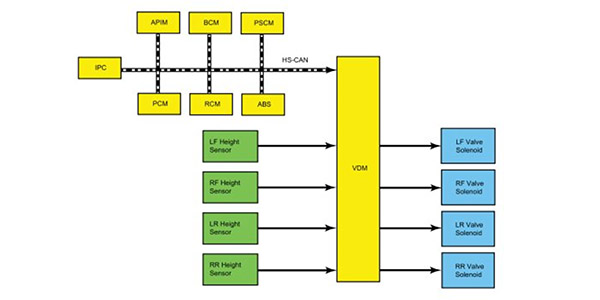
On 2014-2017 Ford Expedition models with the Vehicle Dynamic Suspension, the system looks at a lot more than just the height of the vehicle to control the pressure in the air springs and the valving of the shocks. The VDM (Vehicle Dynamics Module) is connected to the high-speed CAN to communicate with other modules like the ECM, BCM and ABS module. The connectivity adds a new diagnostic angle when dealing with codes and warnings in the instrument cluster.
The VDM gathers vehicle suspension height information from the four height sensors. Since the module is connected to the high-speed CAN network, other information like brake pedal and steering angle can is correlated with the height sensor data. With the data, the VDM has a complete picture of the vehicle’s dynamics like heave, roll, pitch, cornering, braking, and acceleration.
All of the information is used to generate a pulse width modulated (PWM) voltage signal for the actuator solenoids that control the valves in the shocks and the rear air springs.
When the VDM is initialized when the vehicle is started, it carries out a preliminary electrical check of the height sensors, height sensor circuits, valve solenoids, and valve solenoid circuits. It will also check-in with the other models on the high-speed CAN network.
If any malfunctions are detected, the VDM module will set a DTC and send a message over the instrument cluster. The shocks and air suspension will go into a fail-safe mode that will put the suspension in a passive mode and stop PWM signals to the shocks. The fail-safe mode is designed to give the vehicle stability over ride comfort. With no movement of the valves, it will produce a firm ride the customer will notice.
If a suspension sensor or component is replaced that alters the relations of the height sensor to the control arms, the VDM needs to be calibrated using a scan tool to learn the zero-position. The procedure needs to carried out on level ground. Also, the suspension must be stabilized before performing the calibration routine by driving the vehicle for a short distance, such as around a parking lot.
Article courtesy Brake & Front End.













